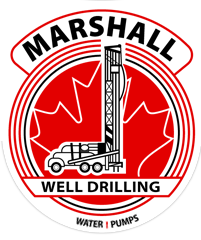
Pour required amount of 5% Javex or household bleach (unscented) into well by taking top portion of well cap off with the 4 vertical bolts.
Agitate column of water by getting a running clean garden hose and putting it in the top of the well and letting it run for approx. 5 min. This circulates the chlorinated water through the system.
Turn garden hose off and recap well.
Go inside home and open each tap, one at a time, until you smell a faint smell of chlorine, then turn off. This will allow chlorinated water to come through all piping and to faucets.
Leave chlorinated water in piping and well for approximately 12 hours.
Clear chlorinated water from well by running an outside hose, open half way not full, until you can no longer smell chlorine. You DO NOT want to run chlorinated water through house plumbing because it will go to septic system and kill the good bacteria that reside there.
NOTE: The worst spot to take water sample is from your kitchen sink. The kitchen sink actually has more bacteria than your toilet bowls. The best spot to take a sample is at the blue pressure tank. There is a garden hose faucet at this site. You should hold a match to garden hose faucet for as long as the flame exists, then run the water for 2 min. before you take sample. Make sure your hands have been washed with disinfectant soap.
|
Depth of Water |
Millilitres of 10% Pool Shock |
|
50 ft. |
150 ml |
|
100 ft. |
300 ml |
|
150 ft. |
450 ml |
|
200 ft. |
600 ml |
|
250 ft. |
750 ml |
|
300 ft. |
900 ml |
|
350 ft. |
1050 ml |
|
400 ft. |
1200 ml |
|
450 ft. |
1350 ml |
|
Depth of Water |
Millilitres of 5% Javex or Bleach |
|
50 ft. |
300 ml |
|
100 ft. |
600 ml |
|
150 ft. |
900 ml |
|
200 ft. |
1200 ml |
|
250 ft. |
1500 ml |
|
300 ft. |
1800 ml |
|
350 ft. |
2100 ml |
|
400 ft. |
2400 ml |
|
450 ft. |
2700 ml |
- Turn pump system off
- Close valve to house plumbing
- Completely drain pressure tank via garden hose faucet on pressure tank
- Check pressure via valve on top of pressure tank with a tire gauge.
- Your PSI in the empty pressure tank should be 2 PSI less than the operating low pressure cut on. Example: If you are operating your system at 30/50, 30 PSI cut on & 50 PSI cut off, then the air pressure in the tank should be 28 PSI WHEN EMPTY.
- If your tank is reading less than 2 PSI of your operating cut on setting, you should fill the tank up with a compressor or air pig to 2 PSI less than operation cut on PSI.
- Once system is 2 PSI less than operating cut on pressure, then you can turn on your pump system.
- Fill pressure tank.
- Slowly open valve to house plumbing.
- Make sure breaker is on, and pump switch if applicable.
- Shut yellow/orange handle valve that goes to house plumbing.
- Locate small silver lever on side of grey box that is on blue pressure tank.
- Hold up on lever until you feel resistance or hear water coming in lines, continue to hold. * If you hear it click you have pulled up too far, this is the off position.
- Watch gauge it should begin to slowly raise, at around 50 PSI it will click off.
- You can now let go of silver lever.
- Slowly open yellow/orange handle valve to house plumbing.
Yard Hydrant Drain Back – Draining System
- Shut power off to system; A/C Disconnect or Breaker in panel.
- Drain pressure tank via the sediment faucet at the pressure tank. Gauge should be reading 0 PSI.
- Make sure ball valve is open.
- Lift handle up on yard hydrant and leave in up position (open). This will allow the line to slowly drain back into the well.
Yard Hydrant Drain Back – Starting System
- Lower handle down in off position on yard hydrant (closed).
- Put garden hose on sediment faucet and open ½ way; this will allow air from the lines to escape.
- Close ball valve.
- Turn power on to the system via the A/C Disconnect or the breaker in the panel; however you powered down the system. Run through garden hose until no air is coming and there is a steady flow of water.
- Open ball valve slowly, allow water to fill your system and check plumbing for leaks.










